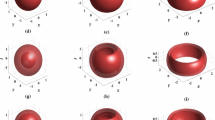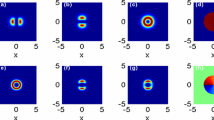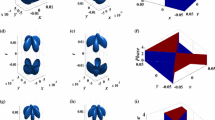Abstract
A (2+1)-dimensional N-coupled nonlinear Schrödinger equation with spatially modulated cubic–quintic nonlinearity and transverse modulation is studied, and vector multipole and vortex soliton solutions are analytically obtained. When the modulation depth q is chosen as 0 and 1, vector multipole and vortex solitons are constructed, respectively. The number of “petals” for the multipole solitons and vortex solitons is related to the value of the topological charge m, and the number of layers in the multipole solitons and vortex solitons is determined by the value of the soliton order number n.
Similar content being viewed by others
Explore related subjects
Discover the latest articles, news and stories from top researchers in related subjects.Avoid common mistakes on your manuscript.
1 Introduction
Dynamics of optical solitons has exhibited novel and vital properties and exists extensive application in many different real backgrounds of nonlinear optics [1,2,3,4,5]. Spatial and spatiotemporal solitons form with the coaction of diffraction, dispersion nonlinearity and/or external potential [6,7,8,9]. As the subject of intensive theoretical and experimental studies, spatial and spatiotemporal solitons exhibit different types of localized structures including fundamental solitons [10, 11], similaritons [12, 13], vortex solitons [14, 15], Hollow multipole soliton [16, 17], rogue waves [18, 19] and Hermite–Gaussian solitons [15, 20], and so on.
When the optical field frequency approaches a resonant frequency of the optical fiber material, the Kerr nonlinearity is not enough to describe self-focusing effect and cubic–quintic (CQ) nonlinearities are considered. According to the work of Pusharov et al. [21], CQ nonlinearities are introduced into the governing equation of the propagation of optical wave, that is, nonlinear Schrödinger equation (NLSE) by considering the refractive index nonlinearity as \(n=n_0+n_2|u|^2 +n_4|u|^4\), where u is the electric field amplitude, \(n_2=3\chi ^{(3)}/(8n_0), n_4=5\chi ^{(5)}/(16n_0)\) with the linear refractive index coefficient \(n_0\), and two components of the corresponding nonlinear dielectric tensors \(\chi ^{(3)}\) and \(\chi ^{(5)}\). Temporal and spatial solitons in the CQ nonlinear media have extensively studied [22, 23]. Historically, the topological quasi-soliton solutions for the variable-coefficient CQNLSE were reported in the pioneering work of Serkin et al. [24]. Avelar et al. [25] obtained periodic wave and soliton solutions with CQ nonlinearities modulated in space and time. Competing CQ nonlinearity in the bulk medium generates stable vortex solitons [26].
Vector spatial solitons with two or more components can mutually self-trap in the nonlinear medium and have much more application in the control of optical beam diffraction, design of the logic gates, all-optical switching devices and information transformation [27, 28]. When two optical waves of different frequencies co-propagate in a medium and interact nonlinearly through the medium, or when two polarization components of a wave interact nonlinearly at some central frequency, the Manakov equation can describe the propagation of solitons [29]. Multicomponent structures for N fields governed by a coupled NLSE make vector solitons possess richer dynamical propagation behaviors than the scalar solitons [29, 30]. Self-trapping of scalar and vector dipole spatial solitons in 2D Kerr media were studied [31]. However, spatial vector solitons in CQ nonlinear medium are relatively few studied. In this paper, we study spatial vector multipole and vortex solitons in a CQ nonlinear medium and discuss the form and structure pattern of these solitons.
2 Exact vector soliton solutions of CQNLSE
The evolution of vector beams consisting of N mutually incoherent components co-propagating in a CQ nonlinear medium with the spatially modulated refractive index \(n=n_0+n_1R(r)+n_2g_3(r)|u|^{2}+n_4g_5(r)|u|^{4}\) can be described by the following N-coupled (2+1)-dimensional variable-coefficient CQNLSE
where \(u_k(z,r,\varphi )(k=1,2, \ldots N)\) are the slowly varying envelopes with the propagation distance z and the polar coordinates r and \(\varphi \) in the transverse plane, as well as the 2D Laplacian \(\nabla _\bot ^{2}=\frac{\partial ^2}{\partial r^2}+\frac{1}{r}\frac{\partial }{\partial r}+\frac{1}{r^2}\frac{\partial ^2}{\partial \varphi ^2}\). The cubic nonlinearity coefficient \(g_3(r)\), quintic nonlinearity coefficient \(g_5(r)\) and the transverse modulation R(r) are all functions of radial coordinate \(r\equiv (x,y)\). The transverse x, y and longitudinal z coordinates, respectively, are normalized to the beam width \(w_0=(2k_0^2n_1)^{-1/4}\) and diffraction length \(L_\mathrm{d}=k_0w_0^2\) with the wave number \(k_0=2\pi n_0/\lambda \) at the input wavelength \(\lambda \). If \(u_k\) represents the macroscopic wave function of the condensate, R(r) is the external potential, Eq. (1) is the coupled CQ Gross–Pitaevskii equation in Bose–Einstein condensates.
We look for the spatially localized stationary exact solution of Eq. (1) in the form
where \(\kappa \) is the propagation constant, and A(r) is a real function for the localization demand \(\lim _{r\rightarrow \pm \infty }A(r)=0\).
Substituting Eq. (2) into Eq. (1) leads to
with the self-consistency condition \(\sum _{k=1}^N|\varPhi _k|^{2}=1\), and the topological charge l.
From Eq. (4), we obtain solution
In the following, we consider two-component case with \(N=2\), thus \(C_1=1,D_1=\text {i} q,C_2=0,C_2=\sqrt{1+q^2}\) with \(q(0\le q\le 1)\). The limit value \(q=1\) corresponds to vortex soliton, and \(q=0\) corresponds to the multipole soliton, where the topological charge \(l=1{-}5\) denotes dipole, quadrupole, hexapole, octopole and dodecagon solitons.
Assuming \(A (r)\equiv \rho (r)U[\chi (r)]\), \(g_3(r)\equiv G_{3}r^{-2}\rho ^{-6}(r)/2,g_5(r)\equiv G_{5}r^{-2}\rho ^{-8}(r)/2\), with \(\chi (r)\equiv \int _{0}^{r}\rho ^{-2} (s)s^{-1}\mathrm{d}s\), Eq. (3) is split into two equations
where \(E,G_3\) and \(G_{5}\) are constants. Note that via the procedure above, the coupled CQNLSE (1) is reduced to solvable stationary CQNLSE (6), which has rich solutions such as Jacobian elliptic function solution and soliton solution [32].
Therefore, it is crucial to construct exact solutions of Eq. (2) to obtain solutions of the underlying coupled CQNLSE (1). Equation (2) is not easily solved. Physical solutions impose several restrictions on \(\rho \): expressions for \(R(r), g_3(r)\) and \(g_5(r)\) hint that \(\rho \) cannot change its sign and diverges (\(\rho \rightarrow \infty \) ) at \(r\rightarrow \infty \); thus, the inhomogeneous nonlinearity strength is bounded and the integration in R(r) converges. If E is a nonzero constant, then Eq. (2) is the Ermakov–Pinney equation [33]; thus, solution of \(\rho (r)\) becomes
where \(E=(\alpha \gamma -\beta ^2)W^2\) with three constants \(\alpha , \beta , \gamma \) and constant Wronskian \(W=\phi _1\phi _{2r}-\phi _2\phi _{1r}\) with \(\phi _1(r)\) and \(\phi _2(r)\) being two linearly independent solutions of \(\phi _{rr}+[2\kappa -2R(r)-l^2/r^2]\phi =0\).
Especially, when \(E=0\) in Eq. (2), if R(r) is the transverse parabolic modulation with \(R(r)=\frac{1}{2}\omega ^2r^{2}\), then \(\rho \) can be found in terms of the Whittaker’s \(\mathrm{M}\) and \(\mathrm{W}\) functions [34], namely, \(\rho (r)=r^{-1}[c_1M(\kappa /2\sqrt{2\omega },l/2,\sqrt{2\omega }r^2) +c_2W(\kappa /2\sqrt{2\omega },l/2,\sqrt{2\omega }r^2)]\), where the restrictions on \(\rho \) require \(c_{1}c_{2}>0\). Without the transverse modulation with \(\omega =0\), \(\rho \) becomes \(\rho (r)=c_3 B_J(l,\sqrt{2\kappa }r)+c_4B_Y(l,\sqrt{2\kappa }r)\), \(B_{J}\) and \(B_{Y}\) being, respectively, the Bessel functions of the first and second kinds [35], and constants satisfying \(c_{3}c_{4}>0\).
Considering the localization condition \(A(0)=A(\infty )=0\), when \(G_5=-3G_3^2/(16\delta ^2)\) with \(\delta =2\sqrt{E/(m^2+4)}\), Eq. (6) has the following exact solution
where the soliton order number \(n=1,2,3, \ldots \), \(\text {sn}(\cdot )\) and \(\text {dn}(\cdot )\) are the Jacobian elliptic sine function and the Jacobian elliptic function of the third kind, respectively, and \(\lambda \equiv K(m)/\chi (\infty )\) with the complete elliptic integral of the first kind K(m) and modulus m. From solution (8), \(G_3>0\) and \(G_5<0\), thus solution (8) exists only in the focusing cubic and defocusing quintic medium.
Therefore, from Eqs. (2), (5), (7) and (8), we can obtain the spatially localized stationary exact solution of Eq. (1).
(Color online) Multipole solitons with the intensity of a, e, i, m component \(|u_1|^2\), b, f, j, n component \(|u_2|^2\), c, g, k, o total quantity \(|u|^2=|u_1|^2+|u_2|^2\) and d, h, l, p phase in the presence of the parabolic transverse modulation \(R=\omega ^2 r^{2}/2\). The parameters are chosen as \(c_{1}=0.8,c_2=0.7,\kappa =0.3,\) \(\omega =0.005,G_3=50,q=0,n=1\) with (a)-(d) \(m=1\), (e)-(h) \(m=2\), (i)-(l) \(m=3\), (m)-(p) \(m=4\)
3 Vector multipole and vortex solitons
Vector multipole and vortex solitons in the presence of the parabolic transverse modulation \(R=\omega ^2 r^{2}/2\) present abundant structures. Vector multipole and vortex solitons with the intensity of (a), (e), (i) and (m) component \(|u_1|^2\), (b), (f), (j) and (n) component \(|u_2|^2\), (c), (g), (k) and (o) total quantity \(|u|^2=|u_1|^2+|u_2|^2\) and (d), (h), (l) and (p) phase are shown in Figs. 1, 2, 3 and 4.
(Color online) Multipole solitons with the intensity of a, e, i, m component \(|u_1|^2\), b, f, j, n component \(|u_2|^2\), c, g, k, o total quantity \(|u|^2=|u_1|^2+|u_2|^2\) and d, h, l, p phase in presence of the parabolic transverse modulation \(R=\omega ^2 r^{2}/2\). The parameters are chosen as the same as those in Fig. 1 except for \(n=2\)
If \(n=1\), the mutually complementary two-petal structures for components \(|u_1|^2\) and \(|u_2|^2\) in Fig. 1a, b constitute a ring structure in Fig. 1c, and the phase of this ring structure is a half-circle in Fig. 1d. The mutually complementary four-“petal” structures for components \(|u_1|^2\) and \(|u_2|^2\) in Fig. 1e, f also constitute a ring structure in Fig. 1g, and the phase of this ring structure is two opposite slices of sectors in Fig. 1h. The mutually complementary six-“petal” structures for components \(|u_1|^2\) and \(|u_2|^2\) in Fig. 1i, j also constitute a ring structure in Fig. 1k, and the phase of this ring structure is three slices of sectors and the angle between two adjacent sectors is 60\(^{\circ }\) in Fig. 1l. The mutually complementary eight-“petal” structures for components \(|u_1|^2\) and \(|u_2|^2\) in Fig. 1m, n also constitute a ring structure in Fig. 1o, and the phase of this ring structure is four slices of sectors, and the angle between two adjacent sectors is 45\(^{\circ }\) in Fig. 1p. Therefore, there exist the mutually complementary 2m-“petal” structures for components \(|u_1|^2\) and \(|u_2|^2\), and the phase is made up of m-slices of sectors. With the add of m, the hole in the center of the ring enlarges.
(Color online) Multipole solitons with the intensity of a, e, i, m component \(|u_1|^2\), b, f, j, n component \(|u_2|^2\), c, g, k, o total quantity \(|u|^2=|u_1|^2+|u_2|^2\) and d, h, l, p phase in the presence of the parabolic transverse modulation \(R=\omega ^2 r^{2}/2\). The parameters are chosen as the same as those in Fig. 1 except for a–d \(m=1,n=3\), e–h \(m=3,n=3\), i–l \(m=1,n=4\), m–p \(m=3,n=4\)
With the increase of the soliton order number n, the layer of multipole solitons adds in Figs. 2 and 3. If \(n=2\), the structure and phase of multipole solitons possess two layers in Fig. 2, and if \(n=3,4\), the structures and phases of multipole solitons possess three and four layers, respectively, in Fig. 3. From phase patterns for (d), (h), (l) and (p) in Figs. 1, 2 and 3, we know these ring-like solitons for (c), (g), (k) and (o) in Figs. 1, 2 and 3 are not vortex solitons because the phases are all not a \(2\pi \) jump around their cores.
(Color online) Vortex solitons with the intensity of a, e, i, m component \(|u_1|^2\), b, f, j, n component \(|u_2|^2\), c, g, k, o total quantity \(|u|^2=|u_1|^2+|u_2|^2\) and d, h, l, p phase in presence of the parabolic transverse modulation \(R=\omega ^2 r^{2}/2\). The parameters are chosen as the same as those in Fig. 1 except for \(q=1\) with a–d \(m=1,n=1\), e–h \(m=2,n=2\), i–l \(m=3,n=3\), m–p \(m=4,n=4\)
When \(q=1\), vortex solitons with the intensity of (a), (e), (i) and (m) component \(|u_1|^2\), (b), (f), (j) and (n) component \(|u_2|^2\), (c), (g), (k) and (o) total quantity \(|u|^2=|u_1|^2+|u_2|^2\) and (d), (h), (l) and (p) phase are shown in Fig. 4 in presence of the parabolic transverse modulation \(R=\omega ^2 r^{2}/2\). Similar to multipole solitons, the soliton order number n decides the layer of vortex solitons. If \(n=1{-}4\), vortex solitons possess one to four layers, respectively. Moreover, the value of m is related to the number of “petal” for vortex solitons, that is, vortex solitons possess the structures with 2m-“petal.” From these plots in Fig. 4d, h, l, p, all phases exhibit a \(2\pi \) jump around their cores, and thus, these structures in Fig. 4 are all vortex solitons.
We find that localized structures without the transverse modulation are similar to those in the presence of the parabolic transverse modulation in Figs. 1, 2, 3 and 4. For the limit of length, we neglect these related discussions.
4 Summary
In summary, we study a (2+1)-dimensional N-coupled NLSE with spatially modulated cubic–quintic nonlinearity and transverse modulation, and analytically derive vector multipole and vortex soliton solutions. If the modulation depth q is chosen as 0 and 1, vector multipole and vortex solitons are constructed, respectively. The number of “petals” for the multipole solitons and vortex solitons is decided by the value of 2m with the topological charge m, and the number of layers in the multipole solitons and vortex solitons is related to the value of the soliton order number n.
References
Zhou, Q., Liu, L., Liu, Y., Yu, H., Yao, P., Wei, C., Zhang, H.: Exact optical solitons in metamaterials with cubic–quintic nonlinearity and third-order dispersion. Nonlinear Dyn. 80, 1365–1371 (2015)
Kong, L.Q., Liu, J., Jin, D.Q., Ding, D.J., Dai, C.Q.: Soliton dynamics in the three-spine \(\alpha \)-helical protein with inhomogeneous effect. Nonlinear Dyn. 87, 83–92 (2017)
Zhou, Q., Zhu, Q., Savescu, M., Bhrawy, A., Biswas, A.: Optical solitons with nonlinear dispersion in parabolic law medium. Proc. Rom. Acad. Ser. A 16, 152–159 (2015)
Zhang, B., Zhang, X.L., Dai, C.Q.: Discussions on localized structures based on equivalent solution with different forms of breaking soliton model. Nonlinear Dyn. 87, 2385–2393 (2017)
Zhou, Q., Liu, L., Liu, Y., Yu, H., Yao, P., Wei, C., Zhang, H.: Exact optical solitons in metamaterials with cubic–quintic nonlinearity and third-order dispersion. Nonlinear Dyn. 80, 1365–1371 (2015)
Wu, H.Y., Jiang, L.H.: Vector Hermite–Gaussian spatial solitons in (2+1)-dimensional strongly nonlocal nonlinear media. Nonlinear Dyn. 83, 713–718 (2016)
Dai, C.Q., Chen, R.P., Wang, Y.Y., Fan, Y.: Dynamics of light bullets in inhomogeneous cubic–quintic–septimal nonlinear media with PT-symmetric potentials. Nonlinear Dyn. 87, 1675–1683 (2017)
Stegeman, G.I., Segev, M.: Optical spatial solitons and their interactions: universality and diversity. Science 286, 1518–1523 (1999)
Dai, C.Q., Wang, X.G.: Light bullet in parity-time symmetric potential. Nonlinear Dyn. 77, 1133–1139 (2014)
Wang, Y.Y., Dai, C.Q., Wang, X.G.: Stable localized spatial solitons in PT-symmetric potentials with power-law nonlinearity. Nonlinear Dyn. 77, 1323–1330 (2014)
Dai, C.Q., Wang, Y.Y.: Spatiotemporal localizations in (3+1)-dimensional PT-symmetric and strongly nonlocal nonlinear media. Nonlinear Dyn. 83, 2453–2459 (2016)
Dai, C.Q., Fan, Y., Zhou, G.Q., Zheng, J., Chen, L.: Vector spatiotemporal localized structures in (3+1)-dimensional strongly nonlocal nonlinear media. Nonlinear Dyn. 86, 999–1005 (2016)
Dai, C.Q., Zhang, J.E.: Controllable dynamical behaviors for spatiotemporal bright solitons on continuous wave background. Nonlinear Dyn. 73, 2049–2057 (2013)
Zhu, H.P., Pan, Z.H.: Vortex soliton in (2+1)-dimensional PT-symmetric nonlinear couplers with gain and loss. Nonlinear Dyn. 83, 1325–1330 (2016)
Zhu, H.P., Chen, L., Chen, H.Y.: Hermite–Gaussian vortex solitons of a (3+1)-dimensional partially nonlocal nonlinear Schrodinger equation with variable coefficients. Nonlinear Dyn. 85, 1913–1918 (2016)
Xu, Y.J.: Hollow ring-like soliton and d ipole soliton in (2+1)-dimensional PT-symmetric nonlinear couplers with gain and loss. Nonlinear Dyn. 83, 1497–1501 (2016)
Wu, H.Y., Jiang, L.H.: Vector Hermite–Gaussian spatial solitons in (2+1)-dimensional strongly nonlocal nonlinear media. Nonlinear Dyn. 83, 713–718 (2016)
Li, J.T., Zhu, Y., Liu, Q.T., Han, J.Z., Wang, Y.Y., Dai, C.Q.: Vector combined and crossing Kuznetsov–Ma solitons in PT-symmetric coupled waveguides. Nonlinear Dyn. 85, 973–980 (2016)
Dai, C.Q., Wang, Y.Y.: Controllable combined Peregrine soliton and Kuznetsov–Ma soliton in PT-symmetric nonlinear couplers with gain and loss. Nonlinear Dyn. 80, 715–721 (2015)
Dai, C.Q., Wang, Y., Liu, J.: Spatiotemporal Hermite–Gaussian solitons of a (3+1)-dimensional partially nonlocal nonlinear Schrodinger equation. Nonlinear Dyn. 84, 1157–1161 (2016)
Pusharov, D.I., Tanev, S.: Bright and dark solitary wave propagation and bistability in the anomalous dispersion region of optical waveguides with third- and fifth-order nonlinearities. Opt. Commun. 124, 354–364 (1996)
Ndzana, F.I., Mohamadou, A., Kofané, T.C.: Modulational instability in the cubic–cquintic nonlinear Schrödinger equation through the variational approach. Opt. Commun. 275, 421–428 (2007)
Dai, C.Q., Wang, Y.: Higher-dimens ional locali zed mode families in parity-time-symmetric potentials with competing nonlinearities. J. Opt. Soc. Am. B 31, 2286–2294 (2014)
Serkin, V.N., Belyaeva, T.L., Alexandrov, I.V., Melchor, G.M.: Novel topological quasi-soliton solutions for the nonlinear cubic–quintic Schrodinger equation model. Proc. SPIE Int. Soc. Opt. Eng. 4271, 292–302 (2001)
Avelar, A.T., Bazeia, D., Cardoso, W.B.: Solitons with cubic and quintic nonlinearities modulated in space and time. Phys. Rev. E 79, 025602 (2009)
Quiroga-Teixeiro, M., Michinel, H.: Stable azimuthal stationary state in quintic nonlinear optical media. J. Opt. Soc. Am. B 14, 2004–2009 (1997)
Agrawal, G.P.: Nonlinear Fiber Optics. Academic, New York (1995)
Gomez-Alcala, R., Dengra, A.: Vector soliton switching by using the cascade connection of saturable absorbers. Opt. Lett. 31, 3137–3139 (2006)
Manakov, S.V.: On the theory of two-dimensional stationary self-focusing of electromagnetic waves. Sov. Phys. JETP 38, 248–253 (1974)
Radhakrishnan, R., Aravinthan, K.: A dark-bright optical soliton solution to the coupled nonlinear Schrödinger equation. J. Phys. A Math. Theor. 40, 13023 (2007)
Zhong, W.P., Belic, M.R., Assanto, G., Malomed, B.A., Huang, T.W.: Self-trapping of scalar and vector dipole solitary waves in Kerr media. Phys. Rev. A 83, 043833 (2011)
Belmonte-Beitia, J., Cuevas, J.: Solitons for the cubic–quintic nonlinear Schrodinger equation with time- and space-modulated coefficients. J. Phys. A Math. Theor. 42, 165201 (2009)
Belmonte-Beitia, J., Perez-Garcia, V.M., Vekslerchik, V., Konotop, V.V.: Localized nonlinear waves in systems with time-and space-modulated nonlinearities. Phys. Rev. Lett. 100, 164102 (2008)
Whittaker, E.T., Watson, G.N.: A Course in Modern Analysis, 4th edn. Cambridge University Press, Cambridge (1990)
Abramowitz, M., Stegun, I.A.: Handbook of Mathematical Functions with Formulas, Graphs, and Mathematical Tables. Dover, New York (1972)
Acknowledgements
This work was supported by the Zhejiang Provincial Natural Science Foundation of China (Grant Nos. LY17A040011 and LY17F050011) and the National Natural Science Foundation of China (Grant Nos. 11404289 and 11375007).
Author information
Authors and Affiliations
Corresponding author
Rights and permissions
About this article
Cite this article
Wang, YY., Chen, L., Dai, CQ. et al. Exact vector multipole and vortex solitons in the media with spatially modulated cubic–quintic nonlinearity. Nonlinear Dyn 90, 1269–1275 (2017). https://doi.org/10.1007/s11071-017-3725-5
Received:
Accepted:
Published:
Issue Date:
DOI: https://doi.org/10.1007/s11071-017-3725-5








